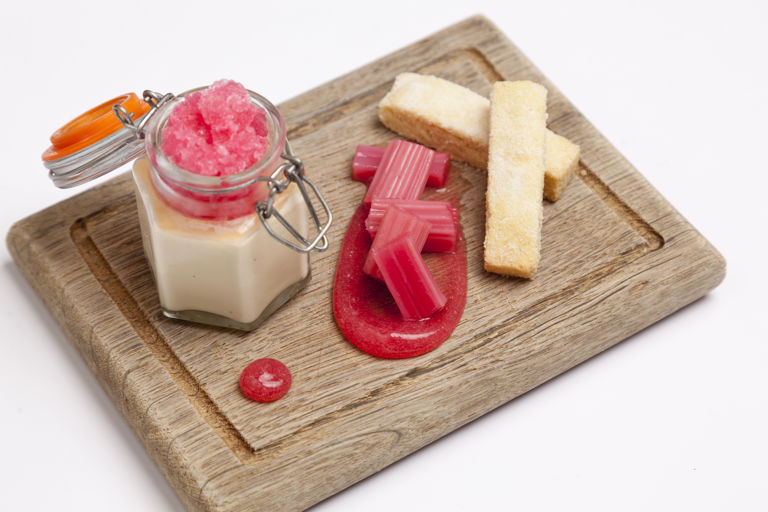Baked custard and rhubarb granita
Item 1 of 1
- medium
- 4
- 3 hours
Emily Watkins' playful take on rhubarb and custard is sure to impress at a late spring/early summer dinner party - when rhubarb is in season and the refreshing granita can be fully appreciated. Presentation is all important with this rhubarb and custard recipe so take time to make sure it looks the part before serving.
First published in 2015
discover more:
Ingredients
Metric
Imperial
Rhubarb granita and gel
- 1000g of forced rhubarb, washed and cut into 1cm pieces
- 150g of caster sugar
- agar agar
Baked custard
- 35ml of milk
- 375ml of cream
- 1 vanilla pod, seeds scraped
- 4 egg yolks
- 20g of caster sugar
Shortbread
- 1 tsp vanilla extract
- 175g of butter
- 60g of caster sugar
- 190g of plain flour
- 45g of cornflour
Poached rhubarb baton
- 300g of sticks of rhubarb, washed
- 45g of caster sugar
SAVE RECIPE
Equipment
- Vac-pac bags
- Squeezy bottle
- Ramekins
Method
1
First, make the rhubarb granita. Place the rhubarb in a vac bag with the sugar and seal tightly.
Place in a pan of simmering water until all of the juice has been relased, the rhubarb breaks down and appears overcooked
- 1000g of forced rhubarb, washed and cut into 1cm pieces
- 150g of caster sugar
2
Alternatively, poach the rhubarb by adding it to a saucepan with about 250ml of water. Cover and cook on a low heat for approximately 20 minutes until the rhubarb has softened. Stir in half of the sugar and simmer, uncovered, until about 30ml of liquid is left. Take off the heat and allow to cool - it should look a little bit like very wet stewed fruit
3
Once the rhubarb is completely soft and cooked, transfer the contents of the bag or pan into a chinois and drain the juice into a bowl
4
Pour half the juice into a small flat tub and place in the freezer. Scrape every half an hour with a fork until completely set and the ice resembles red snow
- agar agar
5
For the gel, stir in 1.1g of agar agar for every 100ml of the remaining hot juice and set in the fridge. Once set, blend until smooth and store in a squeezy bottle until required
6
Preheat the oven to 160°C/gas mark 3
7
For the shortbread, cream the butter, sugar and vanilla extract together in a mixing bowl until light and fluffy. Gently mix in the flours until just combined
- 175g of butter
- 60g of caster sugar
- 190g of plain flour
- 1 tsp vanilla extract
- 45g of cornflour
8
Once the mix has formed a smooth dough, shape into a ball, wrap in cling film and leave to chill in the fridge to rest for approximately 20 minutes. Then, on a lightly floured surface, roll out to 1cm thick and cut into finger shapes
9
Transfer the shortbread fingers onto a lined baking tray and bake in the oven for 10-12 minutes until golden. If the dough feels very soft before baking, place back into the fridge to chill and firm up for 10-15 minutes to help hold its shape
10
Reduce the oven to 95°C
11
To make the baked custards, place the milk, cream and vanilla into a pan and bring to a simmer
- 35ml of milk
- 375ml of cream
- 1 vanilla pod, seeds scraped
12
Meanwhile, thoroughly whisk the yolks and sugar until thick, pale and creamy. Remove the hot cream mixture from the heat and slowly pour into the yolks while whisking. Use a ladle to skim off any bubbles that rise to the surface
- 4 egg yolks
- 20g of caster sugar
13
Pour into ramekins or kilner jars and use a blowtorch to knock out any last bubbles, or alternatively use a small piece of cling film to dab the surface of the liquid to remove the bubbles
14
Place on a tray and into the oven for 30-45 minutes until the custard is just set and has a slight wobble to it. There s not need for a bain marie due to the low oven temperature
15
To make the batons, place the rhubarb in a vac pac bag with the sugar and seal tightly. Place in a pan of simmering water (80˚C) until tender, but still holding its shape, approximately 15-20 minutes
- 300g of sticks of rhubarb, washed
- 45g of caster sugar
16
To plate, top the custard with a generous spoonful of the rhubarb granita. Add a smear of rhubarb gel to the plate and top with poached rhubarb batons. Place the shortbread biscuits alongside the rhubarb and serve
Get in touch
Please sign in or register to send a comment to Great British Chefs.



